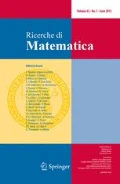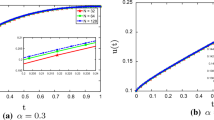Abstract
Volterra’s model for population growth in a closed system includes an integral term to indicate accumulated toxicity in addition to the usual terms of the logistic equation, that occurs in ecology. In this paper, a new numerical approximation is introduced for solving this model of arbitrary (integer or fractional) order. The proposed numerical approach is based on the generalized fractional order Chebyshev orthogonal functions of the first kind and the collocation method. Accordingly, we employ a collocation approach, by computing through Volterra’s population model in the integro-differential form. This method reduces the solution of a problem to the solution of a nonlinear system of algebraic equations. To illustrate the reliability of this method, we compare the numerical results of the present method with some well-known results in order to show that the new method is efficient and applicable.









Similar content being viewed by others
References
Boyd, J.P.: Chebyshev spectral methods and the Lane–Emden problem. Numer. Math. Theor. Methods Appl. 4(2), 142–157 (2011)
Parand, K., Nikarya, M., Rad, J.A.: Solving non-linear Lane–Emden type equations using Bessel orthogonal functions collocation method. Celest. Mech. Dyn. Astr. 16(21), 97–107 (2013)
Shen, J., Tang, T., Wang, L.L.: Spectral Methods Algorithms, Analysis and Applications, 1st edn. Springer, New York (2001)
Rad, J.A., Parand, K., Ballestra, L.V.: Pricing European and American options by radial basis point interpolation. Appl. Math. Comput. 251, 363–377 (2015)
D’Amore, L.: Remarks on numerical algorithms for computing the inverse Laplace transform. Ricerche Mat. 63(2), 239–252 (2014)
Parand, K., Dehghan, M., Pirkhedri, A.: The Sinc-collocation method for solving the Thomas–Fermi equation. J. Comput. Appl. Math. 237(1), 244–252 (2013)
Shen, J., Tang, T.: High Order Numerical Methods and Algorithms. Chinese Science Press, China (2005)
Rad, J.A., Parand, K., Kazem, S.: A numerical investigation to viscous flow over nonlinearly stretching sheet with chemical reaction, heat transfer and magnetic field. Int. J. Appl. Comput. Math. In press pp. 1–17 (2016)
Rad, J.A., Parand, K., Abbasbandy, S.: Local weak form meshless techniques based on the radial point interpolation (RPI) method and local boundary integral equation (LBIE) method to evaluate European and American options. Commun. Nonlinear Sci. Numer. Simul. 22(1), 1178–1200 (2015)
Parand, K., Dehghan, M., Taghavi, A.: Modified generalized Laguerre function Tau method for solving laminar viscous flow: the Blasius equation. Int. J. Numer. Methods. Heat 20(7), 728–743 (2010)
Kazem, S., Abbasbandy, S., Kumar, S.: Fractional-order Legendre functions for solving fractional-order differential equations. Appl. Math. Model. 37, 5498–5510 (2013)
Kilbas, A.A., Srivastava, H.M., Trujillo, J.J.: Theory and Applications of Fractional Differential Equations. Elsevier, San Diego (2006)
Delkhosh, M.: Introduction of derivatives and integrals of fractional order and its applications. Appl. Math. Phys. 1(4), 103–119 (2013)
Odibat, Z., Momani, S.: An algorithm for the numerical solution of differential equations of fractional order. J. Appl. Math. Inf. 26, 15–27 (2008)
Szego, G.: Orthogonal Polynomials. American Mathematical Society Providence, Rhode Island (1975)
Ross, R.: The Prevention of Malaria. E.P. Dutton & Company, New York, London (1911)
D’Ancona, U.: La Lotta per l’Esistenza. G. Einaudi, Torino (1942)
Sharpe, F.R., Lotka, A.J.: Contribution to the analysis of malaria epidemiology IV: Incubation lag. Am. J. Epidemiol. 3, 96–112 (1923)
Lotka, A.: Elements of Physical Biology. Williams & Wilkins Company, New York (1925)
Scudo, F.M.: Vito Volterra and theoretical ecology. Theor. Popul. Biol. 2(1), 1–23 (1971)
TeBeest, K.G.: Numerical and analytical solutions of Volterra’s population model. SIAM Rev. 39(3), 484–493 (1997)
Small, R.D.: Population growth in a closed system. SIAM Rev. 25(1), 93–95 (1983)
Wazwaz, A.M.: Analytical approximation and Pade approximation for Volterra’s population model. Appl. Math. Comput. 100, 13–25 (1999)
Parand, K., Rezaei, A., Taghavi, A.: Numerical approximations for population growth model by rational Chebyshev and Hermite functions collocation approach: a comparison. Math. Methods Appl. Sci. 33(17), 2076–2086 (2010)
Parand, K., Delafkar, Z., Pakniat, N., Pirkhedri, A., Haji, M.K.: Collocation method using Sinc and Rational Legendre function for solving Volterra’s population model. Commun. Nonlinear Sci. Numer. Simul. 16, 1811–1819 (2011)
Parand, K., Abbasbandy, S., Kazem, S., Rad, J.A.: A novel application of radial basis functions for solving a model of first-order integro-ordinary differential equation. Commun. Nonlinear Sci. Num. Simul. 16, 4250–4258 (2001)
Parand, K., Rad, J.A., Nikarya, M.: A new numerical algorithm based on the first kind of modified Bessel function to solve population growth in a closed system. Int. J. Comput. Math. 91(6), 1239–1254 (2014)
Parand, K., Hojjati, G.: Solving Volterra’s population model using new second derivative multistep methods. Am. J. Appl. Sci. 5(8), 1019–1022 (2008)
Parand, K., Hossayni, S.A., Rad, J.A.: Operation matrix method based on Bernstein polynomials for the Riccati differential equation and Volterra population model. Appl. Math. Model. 40(2), 993–1011 (2016)
Momani, S., Qaralleh, R.: Numerical approximations and Pade approximations for a fractional population growth model. Appl. Math. Model. 31, 1907–1914 (2007)
Xu, H.: Analytical approximations for a population growth model with fractional order. Commun. Nonliear Sci. Numer. Simul. 14, 1978–1983 (2009)
Luca, R.D.: On the long-time dynamics of nonautonomous predator-prey models with mutual interference. Ricerche Mat. 61(2), 275–290 (2012)
Messina, E., Russo, E., Vecchio, A.: Volterra integral equations on time scales: stability under constant perturbations via Liapunov direct method. Ricerche Mat. 64(2), 345–355 (2015)
Erturk, V.S., Yildirim, A., Momanic, S., Khan, Y.: The differential transform method and Pade approximates for a fractional population growth model. Int. J. Numer. Method. Hydrol. 22(6), 791–802 (2012)
Momani, S., Qaralleh, R.: Numerical approximations and Pade approximates for a fractional population growth model. Appl. Math. Model. 31, 1907–1914 (2007)
Yuzbasi, S.: A numerical approximation for Volterra’s population growth model with fractional order. Appl. Math. Model. 37, 3216–3227 (2013)
Parand, K., Nikarya, M.: Application of Bessel functions for solving differential and integro-differential equations of the fractional order. Appl. Math. Model. 38, 4137–4147 (2014)
Maleki, M., Kajani, M.T.: Numerical approximations for Volterra’s population growth model with fractional order via a multi-domain pseudospectral method. Appl. Math. Model. 39(15), 4300–4308 (2015)
Khan, N.A., Mahmood, A., Khan, N.A., Ara, A.: Analytical study of nonlinear fractional-order integro-differential equation: Revisit Volterra’s population model. Int. J. Differ. Equ. 2012, 8 Article ID 845945 (2012)
Ghasemi, M., Fardi, M., Ghazizni, R.K.: A new application of the homotopy analysis method in solving the fractional Volterra’s population system. Appl. Math. 59(3), 319–330 (2014)
Eslahchi, M.R., Dehghan, M., Amani, S.: Chebyshev polynomials and best approximation of some classes of functions. J. Numer. Math. 23(1), 41–50 (2015)
Bhrawy, A.H., Alofi, A.S.: The operational matrix of fractional integration for shifted Chebyshev polynomials. Appl. Math. Lett. 26, 25–31 (2013)
Doha, E.H., Bhrawy, A.H., Ezz-Eldien, S.S.: A Chebyshev spectral method based on operational matrix for initial and boundary value problems of fractional order. Comput. Math. Appl. 62, 2364–2373 (2011)
Nkwanta, A., Barnes, E.R.: Two Catalan-type Riordan arrays and their connections to the Chebyshev polynomials of the first kind. J. Integer Seq. 15, 1–19 (2012)
Lslie, F., Parker, I.B.: Chebyshev Polynomials in Numerical Analysis, 29th edn. Oxford University Press, London (1968)
Saadatmandi, A., Dehghan, M.: Numerical solution of hyperbolic telegraph equation using the Chebyshev tau method. Numer. Methods. Partial Differ. Equ. 26(1), 239–252 (2010)
Parand, K., Taghavi, A., Shahini, M.: Comparison between rational Chebyshev and modified generalized Laguerre functions pseudospectral methods for solving Lane–Emden and unsteady gas equations. Acta Phys. Polon. B 40(12), 1749–1763 (2009)
Parand, K., Shahini, M., Taghavi, A.: Generalized Laguerre polynomials and rational Chebyshev collocation method for solving unsteady gas equation. Int. J. Contemp. Math. Sci. 4(21), 1005–1011 (2009)
Parand, K., Abbasbandy, S., Kazem, S., Rezaei, A.R.: An improved numerical method for a class of astrophysics problems based on radial basis functions. Physica Script. 83, 11, 015011 (2011)
Parand, K., Shahini, M.: Rational Chebyshev pseudospectral approach for solving Thomas–Fermi equation. Phys. Lett. A 373, 210–213 (2009)
Parand, K., Khaleqi, S.: The rational Chebyshev of second kind collocation method for solving a class of astrophysics problems. Euro. Phys. J. Plus 131, 1–24 (2016)
Parand, K., Shahini, M., Dehghan, M.: Solution of a laminar boundary layer flow via a numerical method. Commun. Nonlinear Sci. Num. Simul. 15(2), 360–367 (2010)
Adomian, G.: Solving Frontier problems of Physics: The Decomposition Method. Kluwer Academic Publishers, Kluwer (1994)
Liao, S.J.: The proposed homotopy analysis technique for the solution of nonlinear problems. PhD thesis, Shanghai Jiao Tong University (1992)
Chowdhury, M.S.H., Hashim, I.: Solution of a class of singular second-order IVPs by Homotopy–Perturbation method. Phys. Lett. A 365, 439–447 (2007)
Darani, M.A., Nasiri, M.: A fractional type of the Chebyshev polynomials for approximation of solution of linear fractional differential equations. Comp. Meth. Differ. Equ. 1, 96–107 (2013)
Butcher, E.A., Ma, H., Bueler, E., Averina, V., Szabo, Z.: Stability of linear time-periodic delay-differential equations via Chebyshev polynomials. Int. J. Numer. Methods. Eng. 59, 895–922 (2004)
Acknowledgments
The authors are very grateful to reviewers and editor for carefully reading the paper and for their comments and suggestions which have improved the paper.
Author information
Authors and Affiliations
Corresponding author
Rights and permissions
About this article
Cite this article
Parand, K., Delkhosh, M. Solving Volterra’s population growth model of arbitrary order using the generalized fractional order of the Chebyshev functions. Ricerche mat. 65, 307–328 (2016). https://doi.org/10.1007/s11587-016-0291-y
Received:
Revised:
Published:
Issue Date:
DOI: https://doi.org/10.1007/s11587-016-0291-y
Keywords
- Fractional order of the Chebyshev functions
- Volterra’s population model
- Mathematical ecology
- Collocation method
- Integro-differential equation




